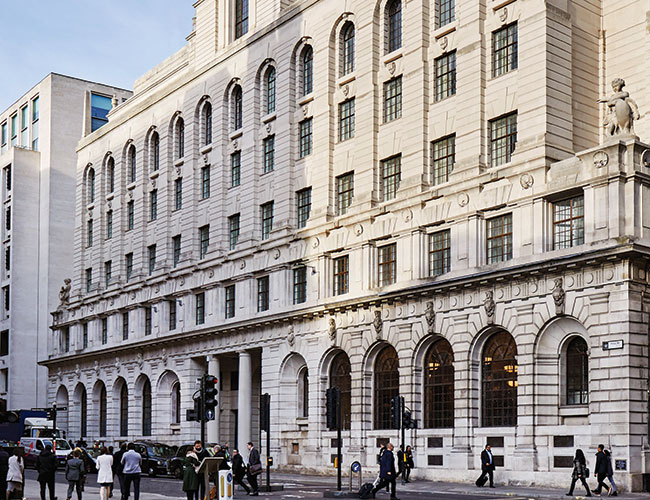 The Ned – the largest and most ambitious hotel, costing 200 million pounds ( NZ $450m) to launch in London this year – is set to welcome its first guests this week. UK’s The Caterer checked out how the £200m (NZ$ 450m) project will create a distinctive hospitality offering for London’s financial inner city Square Mile.
The Ned – the largest and most ambitious hotel, costing 200 million pounds ( NZ $450m) to launch in London this year – is set to welcome its first guests this week. UK’s The Caterer checked out how the £200m (NZ$ 450m) project will create a distinctive hospitality offering for London’s financial inner city Square Mile.
Nick Jones never intended to open a hotel in the City of London. The capital’s financial centre is not a typical location for an outpost of Soho House & Co, the company founded by Jones 22 years ago and renowned for attracting guests and members from the media and entertainment industries.
However, the moment he walked into the former Sir Edwin Lutyens-designed Midland Bank building on Poultry, just a minute’s walk from the Bank of England, Jones was bowled over by what he saw.
“The banking floor was jaw-droppingly beautiful,” he recalls. “I clambered up on the roof, with its views over St Paul’s, and immediately saw the huge potential the property offered as a hotel and collection of restaurants.”
Jones, named by The Caterer as the 2015 Hotelier of the Year, had been tipped off about the building by the landlord of Little House, one of 18 members’ clubs owned and operated by Soho House & Co worldwide. “I wasn’t particularly keen to go along, but I didn’t want to appear rude,” he recalls.
It proved to be a fortuitous visit, leading to the opening five years later of the Ned, unquestionably one of London’s most ambitious hotel launches for some time. Featuring 252 bedrooms, nine restaurants, two swimming pools – one on the rooftop and one in the basement – a spa, members’ club and much more, the Ned is a beautiful, multifaceted beast, which required the help of a partner to create.
After speaking to Ron Burkle, the American investor who acquired a 60% stake in Soho House & Co in 2012, Jones met with Andrew Zobler, the founder and chief executive of Sydell Group. Burkle is also the main financial backer of Sydell Group, a company that has experience of grand renovation projects through the opening of six hotels in the US during the past five years.
While Soho House & Co has extensive experience of developing a variety of hospitality businesses – as well as the members’ clubs (12 of which feature bedrooms and welcome non-members), it has also created 16 restaurant brands – nothing comes close to the scale of the Ned, which covers nearly 30,000 square metres.
For Zobler, a lawyer turned hotel developer, the attraction of the Ned was immediately apparent. “I love old buildings with provenance,” he says. “As well as being a grand historical building, the Ned has many subtle touches. It is an extraordinary property that I fell in love with. Our job was to help Soho House best use the space – something other developers had not been able to work out.”
Zobler’s widespread experience has included turning an early 20th century former office building into the 168-bedroom NoMad in New York and creating the 388-bedroom the Line within a 1960s brutalist building in Los Angeles. However, the Ned, named after Lutyens’ nickname, was by far the largest project he has been involved with so far.
“The trick in a building of this size is to make a large space appear intimate and personal. Both Nick and I share the same philosophy of wanting to create intimate hotels with clubby spaces that delight the guests.”
Throughout the process, Zobler has pushed and probed Jones to ensure he and his team made the most of the building, encouraging him to look to its banking heritage for design cues. Hence, much use has been made of the banking hall’s original walnut-panelled counters, used by tellers, repurposed as bar counters and dividers between the different restaurants. Once bustling with bank customers, the space will now buzz with some 850 restaurant customers at any one time. Meanwhile, in the basement, the bank vaults feature a lounge bar, where more than 3,000 original stainless steel, engraved safety deposit boxes, which once stored gold bullion deposits of £335m (£15b in today’s money) and two metre-wide door have been retained.
The in-house design team of Adam Geco, Alice Lund and Rebecca King has led the process of creating a hotel that is inspired by the faded glamour of a transatlantic ocean liner during the 1930s, the era in which Lutyens’ building originally opened.
The bedrooms are designed to represent the hierarchy of a 1930s bank, with a cosy room featuring floral wallpaper indicating the sort of place a mail clerk might live (from £250 per night). The medium rooms (from £298), which are full of Art Deco touches, with a walnut king-size bed and floral glass chandelier, may have accommodated a junior banker. Meanwhile, the large rooms (from £383), where a director may have lived, feature a super king-size four-poster bed and a mahogany enclosed bath in the bedroom, inspired by Lord Bute’s tub at Cardiff Castle.
At one end of the bedroom scale are the crash pads – 15 of them – which under-30s can book for £150. At 17-19 square metres, they offer much more than the smallest rooms available in many a budget hotel at a similar price point in the capital, and include a marble mosaic bathroom with a walk-in rainforest shower and the full range of Cowshed products.
Ultimate luxury
The top-priced room is the Lutyens Suite, which, when compared with the most expensive suites in London’s luxury hotels, is competitively priced at a starting rate of £1,998. Located on the seventh floor, the suite offers a 100 square metre space across two bedrooms, a lounge with an eight-seat corner sofa, bar and dining space.
It is, however, the banking hall, with its 92 green verdite marble columns and the previously mentioned walnut counters, which creates the biggest wow factor of the project. Together with the fourth and fifth floors, the ground floor is Grade I-listed and therefore little could be done to alter its key features. English Heritage, says Jones, has been very realistic in enabling the building to be made practical for today’s world, while ensuring its preservation.
“We’ve done lots of individual restaurants before, but creating eight on one floor is another matter altogether,” explains Jones. “Until it is fully operational, I’m not sure if we’ve pulled it off.” – Abridged from Jane Harmer, The Caterer.
The Ned 27-35 Poultry, London EC2R 8AJ www.thened.com








